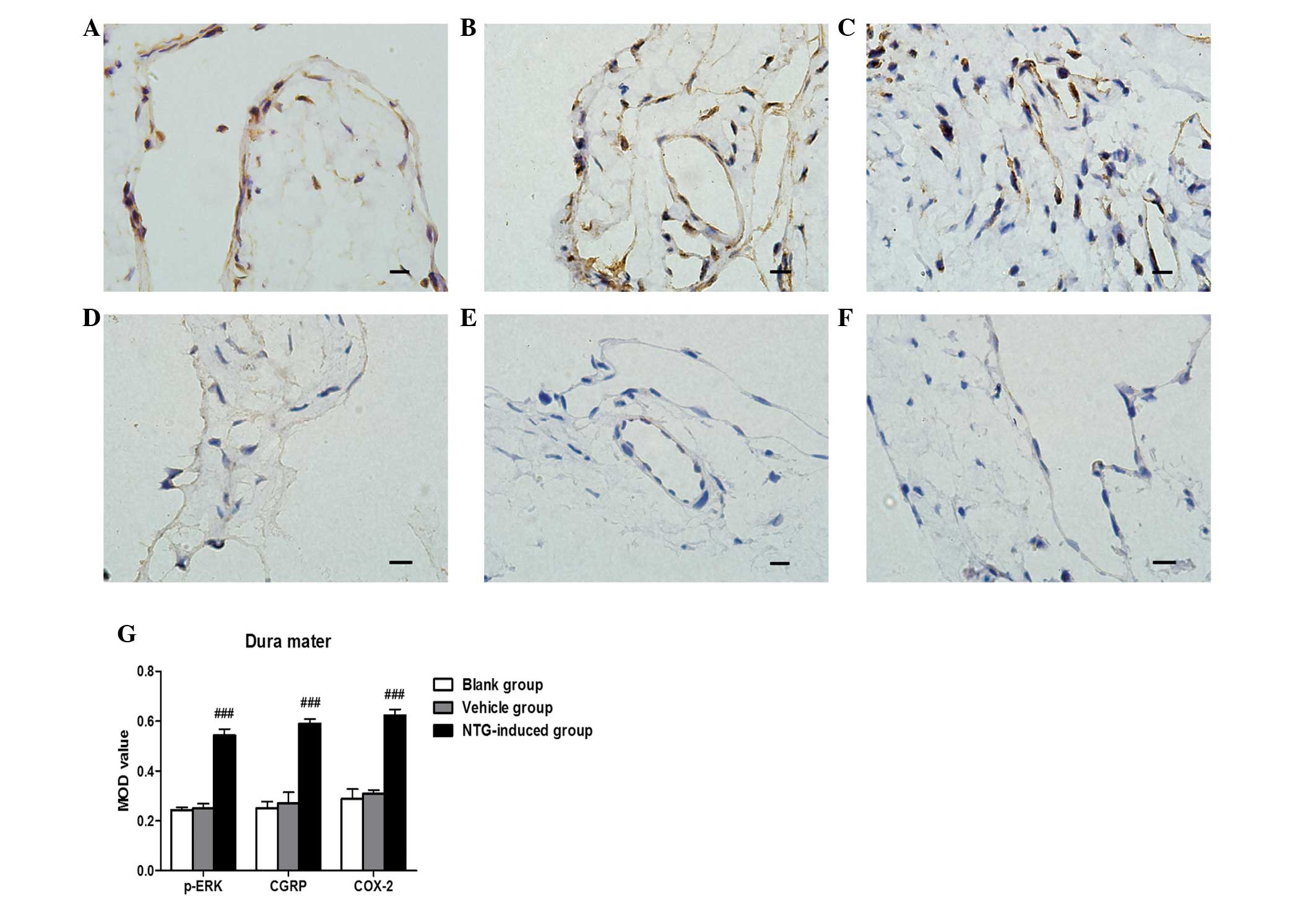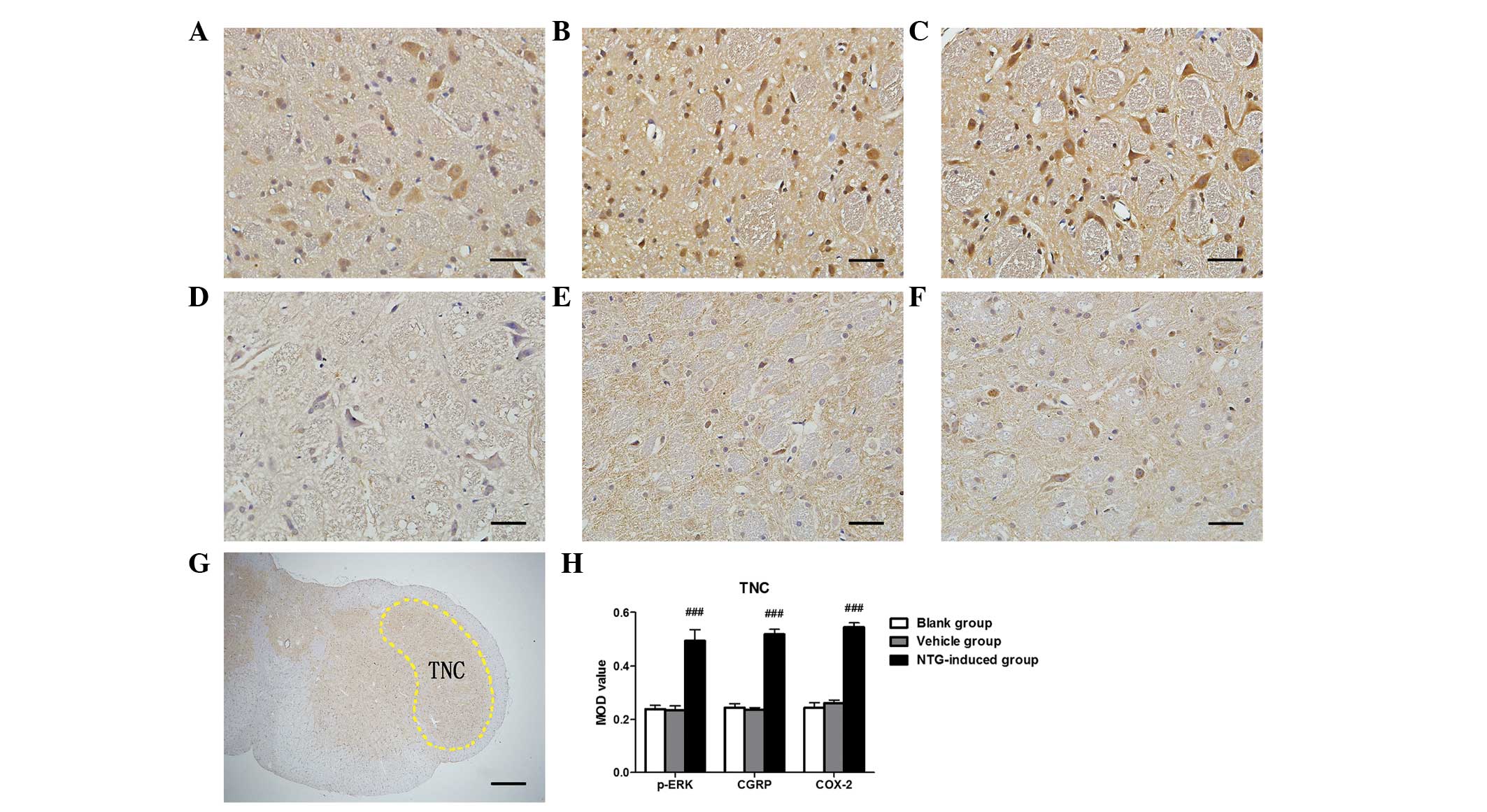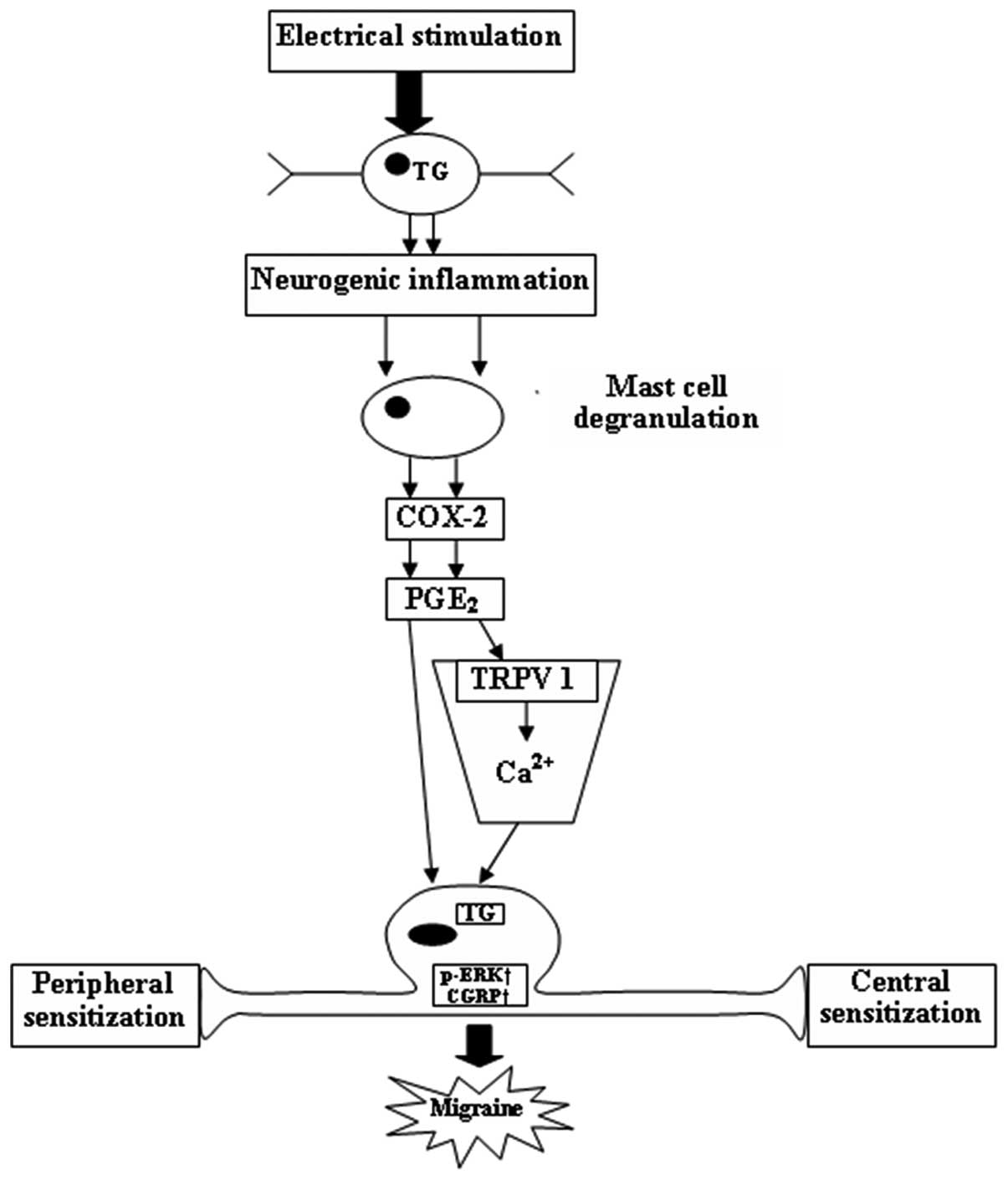|
1
|
Noseda R and Burstein R: Migraine
pathophysiology: Anatomy of the trigeminovascular pathway and
associated neurological symptoms, cortical spreading depression,
sensitization and modulation of pain. Pain. 154(Suppl 1): S44–S53.
2013. View Article : Google Scholar
|
|
2
|
Kojić Z and Stojanović D: Pathophysiology
of migraine - from molecular to personalized medicine. Med Pregl.
66:53–57. 2013. View Article : Google Scholar
|
|
3
|
Goadsby PJ: Recent advances in
understanding migraine mechanisms, molecules and therapeutics.
Trends Mol Med. 13:39–44. 2007. View Article : Google Scholar
|
|
4
|
Knyihar-Csillik E, Tajti J, Mohtasham S,
Sari G and Vecsei L: Electrical stimulation of the Gasserian
ganglion induces structural alterations of calcitonin gene-related
peptide-immunoreactive perivascular sensory nerve terminals in the
rat cerebral dura mater: a possible model of migraine headache.
Neurosci Lett. 184:189–192. 1995. View Article : Google Scholar : PubMed/NCBI
|
|
5
|
Louter MA, Bosker JE, van Oosterhout WP,
et al: Cutaneous allodynia as a predictor of migraine
chronification. Brain. 136:3489–3496. 2013. View Article : Google Scholar : PubMed/NCBI
|
|
6
|
Burstein R, Yarnitsky D, Goor-Aryeh I,
Ransil BJ and Bajwa ZH: An association between migraine and
cutaneous allodynia. Ann Neurol. 47:614–624. 2000. View Article : Google Scholar : PubMed/NCBI
|
|
7
|
Lovati C, Mariotti C, Giani L, et al:
Central sensitization in photophobic and non-photophobic
migraineurs: possible role of retino nuclear way in the central
sensitization process. Neurol Sci. 34(Suppl 1): S133–S135. 2013.
View Article : Google Scholar : PubMed/NCBI
|
|
8
|
Roux PP and Blenis J: ERK and p38
MAPK-activated protein kinases: a family of protein kinases with
diverse biological functions. Microbiol Mol Biol Rev. 68:320–344.
2004. View Article : Google Scholar : PubMed/NCBI
|
|
9
|
Shimizu K, Asano M, Kitagawa J, et al:
Phosphorylation of extracellular signal-regulated kinase in
medullary and upper cervical cord neurons following noxious tooth
pulp stimulation. Brain Res. 1072:99–109. 2006. View Article : Google Scholar : PubMed/NCBI
|
|
10
|
Zhang X, Kainz V, Zhao J, Strassman AM and
Levy D: Vascular extracellular signal-regulated kinase mediates
migraine-related sensitization of meningeal nociceptors. Ann
Neurol. 73:741–750. 2013. View Article : Google Scholar : PubMed/NCBI
|
|
11
|
Iwashita T, Shimizu T, Shibata M, et al:
Activation of extracellular signal-regulated kinase in the
trigeminal ganglion following both treatment of the dura mater with
capsaicin and cortical spreading depression. Neurosci Res.
77:110–119. 2013. View Article : Google Scholar : PubMed/NCBI
|
|
12
|
Durham PL: Calcitonin gene-related peptide
(CGRP) and migraine. Headache. 46(Suppl 1): S3–S8. 2006. View Article : Google Scholar : PubMed/NCBI
|
|
13
|
Kim GM, Jin KS and Chung CS: Differential
effects of corticosteroids on the expression of cyclooxygenase-2,
tumour necrosis factor-alpha and matrix metalloproteinase-9 in an
animal model of migraine. Cephalalgia. 28:1179–1187. 2008.
View Article : Google Scholar : PubMed/NCBI
|
|
14
|
Waeber C and Moskowitz MA: Migraine as an
inflammatory disorder. Neurology. 64(Suppl 2): S9–S15. 2005.
View Article : Google Scholar : PubMed/NCBI
|
|
15
|
Storer RJ, Akerman S and Goadsby PJ:
Calcitonin gene-related peptide (CGRP) modulates nociceptive
trigeminovascular transmission in the cat. Br J Pharmacol.
142:1171–1181. 2004. View Article : Google Scholar : PubMed/NCBI
|
|
16
|
Neeb L, Hellen P, Boehnke C, et al: IL-1β
stimulates COX-2 dependent PGE2 synthesis and CGRP
release in rat trigeminal ganglia cells. PLoS one. 6:e173602011.
View Article : Google Scholar
|
|
17
|
Kawabata A: Prostaglandin E2 and pain - an
update. Biol Pharm Bull. 34:1170–1173. 2011. View Article : Google Scholar
|
|
18
|
Tassorelli C, Greco R, Armentero MT,
Blandini F, Sandrini G and Nappi G: A role for brain
cyclooxygenase-2 and prostaglandin-E2 in migraine: effects of
nitroglycerin. Int Rev Neurobiol. 82:373–382. 2007.PubMed/NCBI
|
|
19
|
Varga H, Pardutz A, Vamos E, et al: Cox-2
inhibitor attenuates NO-induced nNOS in rat caudal trigeminal
nucleus. Headache. 47:1319–1325. 2007. View Article : Google Scholar : PubMed/NCBI
|
|
20
|
Iversen HK, Olesen J and Tfelt-Hansen P:
Intravenous nitroglycerin as an experimental model of vascular
headache. Basic characteristics. Pain. 38:17–24. 1989. View Article : Google Scholar : PubMed/NCBI
|
|
21
|
Tassorelli C and Joseph SA: Systemic
nitroglycerin induces Fos immunoreactivity in brainstem and
forebrain structures of the rat. Brain Res. 682:167–181. 1995.
View Article : Google Scholar : PubMed/NCBI
|
|
22
|
Tassorelli C, Greco R, Wang D, Sandrini M,
Sandrini G and Nappi G: Nitroglycerin induces hyperalgesia in rats
- a time-course study. Eur J Pharmacol. 464:159–162. 2003.
View Article : Google Scholar : PubMed/NCBI
|
|
23
|
Kaiser EA and Russo AF: CGRP and migraine:
Could PACAP play a role too? Neuropeptides. 47:451–461. 2013.
View Article : Google Scholar : PubMed/NCBI
|
|
24
|
Ramachandran R, Bhatt DK, Ploug KB, et al:
Nitric oxide synthase, calcitonin gene-related peptide and NK-1
receptor mechanisms are involved in GTN-induced neuronal
activation. Cephalalgia. 34:136–147. 2014. View Article : Google Scholar
|
|
25
|
Aguggia M, Saracco M, Cavallini M, Bussone
G and Cortelli P: Sensitization and pain. Neurol Sci. 34(Suppl 1):
S37–S40. 2013. View Article : Google Scholar : PubMed/NCBI
|
|
26
|
Silberstein SD: Migraine pathophysiology
and its clinical implications. Cephalalgia. 24(Suppl 2): 2–7. 2004.
View Article : Google Scholar : PubMed/NCBI
|
|
27
|
Arulmani U, Gupta S, VanDenBrink AM,
Centurión D, Villalón C and Saxena P: Experimental migraine models
and their relevance in migraine therapy. Cephalalgia. 26:642–659.
2006. View Article : Google Scholar : PubMed/NCBI
|
|
28
|
Varga H, Pardutz A, Vamos E, et al:
Selective inhibition of cyclooxygenase-2 attenuates
nitroglycerin-induced calmodulin-dependent protein kinase II alpha
in rat trigeminal nucleus caudalis. Neurosci Lett. 451:170–173.
2009. View Article : Google Scholar : PubMed/NCBI
|
|
29
|
Tassorelli C, Greco R, Morazzoni P, Riva
A, Sandrini G and Nappi G: Parthenolide is the component of
tanacetum parthenium that inhibits nitroglycerin-induced Fos
activation: studies in an animal model of migraine. Cephalalgia.
25:612–621. 2005. View Article : Google Scholar : PubMed/NCBI
|
|
30
|
Dai Y, Iwata K, Fukuoka T, et al:
Phosphorylation of extracellular signal-regulated kinase in primary
afferent neurons by noxious stimuli and its involvement in
peripheral sensitization. J Neurosci. 22:7737–7745. 2002.PubMed/NCBI
|
|
31
|
Levy D, Burstein R, Kainz V, Jakubowski M
and Strassman AM: Mast cell degranulation activates a pain pathway
underlying migraine headache. Pain. 130:166–176. 2007. View Article : Google Scholar : PubMed/NCBI
|
|
32
|
Obata K and Noguchi K: MAPK activation in
nociceptive neurons and pain hypersensitivity. Life Sci.
74:2643–2653. 2004. View Article : Google Scholar : PubMed/NCBI
|















